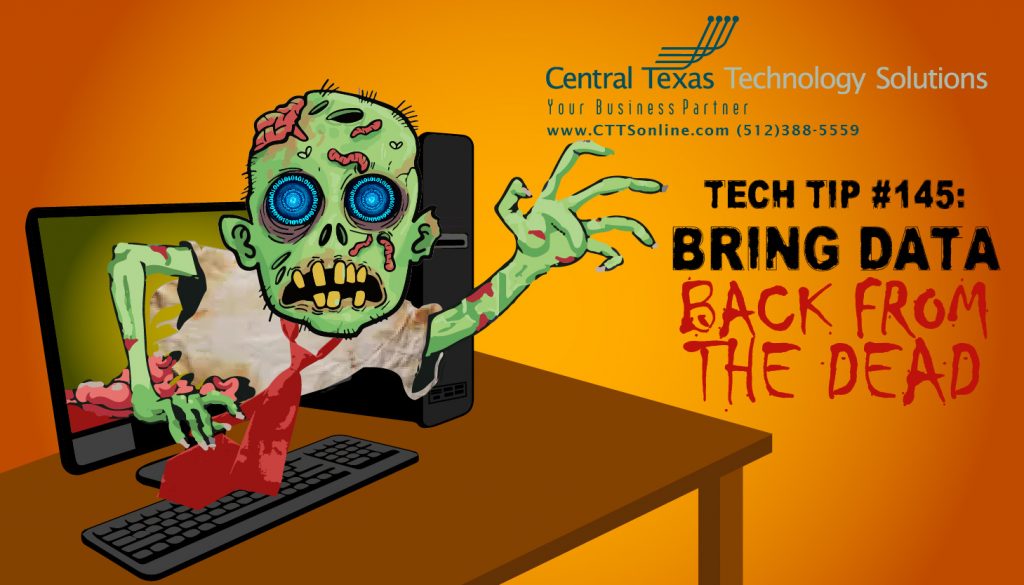 It was a dark and stormy October night, and Jason's office lost power several times during the storm. Upon returning to work the next day, Jason found that his computer wouldn't power on like it usually does. The power surge had corrupted his computer's hard drive and all of his business essential data was irretrievable. "Jason" may seem like a fictional character, but only his name is fictional. Unfortunately, this exact incident has happened to numerous businesses in the past week.
It was a dark and stormy October night, and Jason's office lost power several times during the storm. Upon returning to work the next day, Jason found that his computer wouldn't power on like it usually does. The power surge had corrupted his computer's hard drive and all of his business essential data was irretrievable. "Jason" may seem like a fictional character, but only his name is fictional. Unfortunately, this exact incident has happened to numerous businesses in the past week.
Data is essential for all types of organizations today, so ensuring access to mission-critical applications and data following a disaster, no matter how small, is critical.
However, business continuity and disaster preparedness are about so much more than that. In other words, you might have important apps up and running somewhere, but that doesn’t matter if your office is underwater and your employees are at home without power. You need to consider the business as a whole in order to keep your business alive and satisfy your customer's needs following a disaster event.
The first step for many businesses is to conduct a business impact analysis (BIA). CTTS is happy to conduct a BIA for your business where we:
• Identify potential events that could negatively impact normal business operations,
• Calculate the likelihood that each event may occur, and
• Quantify the impact that the event could have on your business.
For example, if your data center is in Florida, a hurricane is a possible event; its likelihood is high (during hurricane season), and your business could be negatively impacted in a big way if downtime is significant. You get the idea. There are a wide variety of threats to any business ranging from natural disasters to security breaches to random accidents—a leaky pipe can have the same impact as a flood if it’s directly above a critical server.
Once you have that stuff sorted, you can move on to crafting specific plans for risk mitigation, disaster response and continuity of operations. To get started, this Tech Tip article will discuss the top four distinct but interconnected business continuity planning essentials so that when, not if, disaster strikes, you're not dead in the water.
- Effective communication - Communication during and following an emergency presents a variety of challenges. So, crafting an employee safety and communication plan that works is absolutely essential. The specifics will vary widely from company to company, but your emergency safety and communication plan must address the following:
- • How the company will ensure employees are safe during a disaster event; and
- • How it will communicate essential information to employees following the event.The first part will depend heavily on the nature and location of your business. Safety planning for a large manufacturing facility will obviously be very different than for a small real estate office, for example. Because of this, it’s very difficult to provide specific best practices for this part of your BC/DR plan. However, the key is to match your safety plan to the specific needs of your organization.For the second part, you will need to first gather a variety of information and make sure that it is well documented, easily accessible and stored in a number of secure locations. This should include up-to-date employee contact information (email, mobile and home phone numbers, emergency contact information, etc.). It should also include a methodology for contacting employees.
Obviously, email is the easiest way to reach a large group of employees, but if your company’s email server is down, you are out of luck. Some businesses employ redundant Exchange servers or cloud-based services to ensure email access. Of course, if you are without Internet access entirely, you’ll need an alternative.
- Keep Customers in the Loop - Managing customer relationships is obviously critical to the ongoing success of your business. As such, it is important to craft a plan for distributing information to your customers during and following a disaster event. The scope of your customer communications plan will vary widely depending on the nature of your business.
Obviously, not every glitch in operations will merit reaching out to your customers. However, if an event occurs that is likely to impact them, it is essential to communicate the details of the issue and explain the steps you are taking to mitigate it. This might mean direct communication to your customers, but it could also mean messaging via traditional and social media. Failure to do so can have a negative impact on the reputation of your organization.  Enable Uptime - When creating an IT disaster recovery plan, it’s important to understand two concepts: recovery time objective (RTO) and recovery point objective (RPO). RTO is the amount of time that it takes to get a system restored following a failure or disaster event. So given the example above, your RTO might amount to 48 hours or more. RPO is the point in time to which data can be restored following the event. So, if you performed a backup at 6pm each night and a server failed at 5pm the following afternoon, your RPO would be 23 hours and any data created during that span would be lost. For many organizations this was unacceptable.
Enable Uptime - When creating an IT disaster recovery plan, it’s important to understand two concepts: recovery time objective (RTO) and recovery point objective (RPO). RTO is the amount of time that it takes to get a system restored following a failure or disaster event. So given the example above, your RTO might amount to 48 hours or more. RPO is the point in time to which data can be restored following the event. So, if you performed a backup at 6pm each night and a server failed at 5pm the following afternoon, your RPO would be 23 hours and any data created during that span would be lost. For many organizations this was unacceptable.- Keep Business Moving - Many organizations today have limited tolerance for downtime. If your employees or customers do not have access to essential applications and data, there will be a direct impact on productivity and revenue. While this sounds obvious, many organizations do not consider the actual costs of downtime for a business. To better understand the cost of downtime, consider the following example using our Recovery Time Calculator to evaluate your recovery time and recovery pointobjectives: https://www.cttsonline.com/rto/
Let’s say your business has 100 employees and on a typical day average hourly revenue is $1,500. In order to perform daily tasks, employees need access to email, a large database and a variety of file-based data. Let’s say the sum of this data amounts to 2 TB and you perform an on-premises incremental backup at 6pm each day which is also copied to a cloud backup service.
Given these parameters, a full restore from a local backup would take 8 and a half hours and downtime would cost your organization $34,000 in lost revenue. When you look at restoring 2 TB from a cloud backup following a disaster, the picture gets considerably more bleak...
Disaster recovery and business continuity planning should be considered a critical aspect of running a business. However, many organizations disregard it completely. Others have some kind of plan in place, but fail to grasp how time-consuming the recovery process can be and the associated cost of downtime. The good news is that today’s data protection technologies and services have greatly improved the IT piece of the business continuity puzzle. There are a wide array of options in the market today at different price points, which enables you to select a product or service tailored to your specific business needs.
If you'd like to learn more about data backup and business continuity, and how to protect your business from unwanted downtime, cybercriminals, and other spooky threats, or if you would like to schedule a free business IT consultation to see where your company stands and what possibilities are open for your business, call CTTS today: (512) 388-5559
CTTS is a complete technology solution provider and the leading IT Support and Managed Service Provider in the Central Texas area. We're located in Georgetown, TX, but we service all of Central Texas and the surrounding areas, including Round Rock and Austin. Learn more about CTTS today!

By Josh Wilmoth
CEO, Central Texas Technology Solutions
